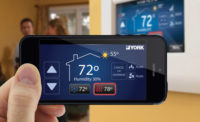Easing Contractor Challenges
Among the challenges faced by contractors as they learn to use blower doors is a simple recognition of its limitations, according to Frank Spevak, marketing and sales manager, The Energy Conservatory (TEC). “I believe that the biggest challenge to the contractor is understanding what a blower door test can and cannot do, and how the information from the test will help them to develop an improvement plan for the house,” he said.
Spevak continued, “While the test itself is relatively simple, we work with many contractors on the phone to help them ensure that their test setup is correct and help them try to interpret the results as they relate to a specific house.”
Bill Spohn, president and CEO of TruTech Tools Ltd., which distributes both Retrotec and TEC blower doors, added, “Many contractors experience setup issues or annoyances like water in one of the pressure measuring tubes, which give false readings.”
However, he noted, “The manufacturers are actively involved in communicating what these common traps are and ways around them.”
Colin Genge, CEO of Retrotec, noted that it “takes a long time to learn how to operate a blower door.”
To ease the learning curve, he pointed out that Retrotec has implemented visual icons on its new gauge.
Overall, Spohn said: “Blower doors are now coming with extensive user manuals along with straightforward quickstart cards to guide setup and use. Additionally, manufacturers are recording videos for 24/7 guidance.”
Plus, he added, “A vibrant end-user community is also taping and posting helpful video guidance on YouTube.”
New Technology
Regarding blower door performance, “End users are looking for simplicity, convenience, and functionality,” said Spohn.
And this past summer, manufacturers responded with new technology designed to make operation easier.
“Recently, both market leaders, TEC and Retrotec, have introduced wireless and touch-screen versions of their digital gauges. These innovations are streamlining work, allowing remote control — throughout a house or anywhere in the world — and providing data-capture capabilities only dreamed of years ago,” Spohn said.
In July, Retrotec released the DM32 digital manometer. The new touch-screen device has Wi-Fi capability and can sync to Apple, Android, and Windows operating systems.
According to Spohn, its graphic on-screen cues should make setup errors a thing of the past.
Genge added, “Trainers say it has cut their blower door operation training down by 75 percent because there is no longer a series of cryptic letters to understand on the screen to be followed by instructions like ‘press xxx three times then press yy twice,’ etc.”
Genge elaborated on the gauge’s communication features.
“It allows communication with the gauge to happen remotely. This is GaugeRemote, like the remote on your TV,” he said. “Then there is VirtualGauge, which allows for remote viewing and two-way operation of the gauge from anywhere in the world.”
Genge pointed out that the applications of this technology are designed to make the contractor’s job easier.
For instance, he said: “It is not necessary to return to the blower door or duct tester to turn it on to find leaks. The contractor could be in the crawlspace or the attic. He can turn on the blower door, locate the leak, and turn it off again. He could also measure the leakage to see if they need to continue sealing to meet code.”
As another example of how the virtual option could be useful, Genge said a contractor could broadcast a test over the Internet for tech support, verification, or training purposes.
Also in July, TEC released its TEC WiFi Link. According to Spevak, this is the update to the company’s standard kit, the Model 3 Minneapolis blower door system with the DG-700 digital pressure and flow gauge.
The new option, Spevak said, “adds a wireless connection to all existing DG-700 gauges, along with accompanying software, TECTITE WiFi and iTEC-700 for iOS.”
He also emphasized the accuracy and stability of the DG-700 readings. “The DG-700 has an accuracy of 1 percent of reading,” he said. “When reading pressure and flow values common in building envelope and combustion appliance zone testing, accuracy at low pressure values can mean the difference of a house passing a test or not.”
Spohn elaborated on TEC’s upgraded option. “The WiFi Link attaches to any DG-700 and creates a wireless network that can be picked up by any computer or mobile device with Wi-Fi capabilities,” he said. “Using the free WiFi Link compatible software for PC or iPhone apps, you can monitor and control the DG-700 gauge from anywhere in a house.”
Looking Ahead
As the home-performance market continues to evolve, you can rest assured that this summer’s improvements to blower door technology and duct leakage testing won’t be the last.
Genge believes that one trend driving future improvements will be “new apps from developers who can sell their products on the open market.”
Looking on the regulatory side, Spevak said: “The biggest trend we see coming is the incorporation of International Energy Conservation Codes (IECC) into state and local building codes. This also includes multifamily and commercial buildings of all sizes. There will be improvements to blower door equipment that will also incorporate new mobile technologies.”
Publication date: 10/7/2013
Want more HVAC industry news and information? Join The NEWS on Facebook, Twitter, and LinkedIn today!











